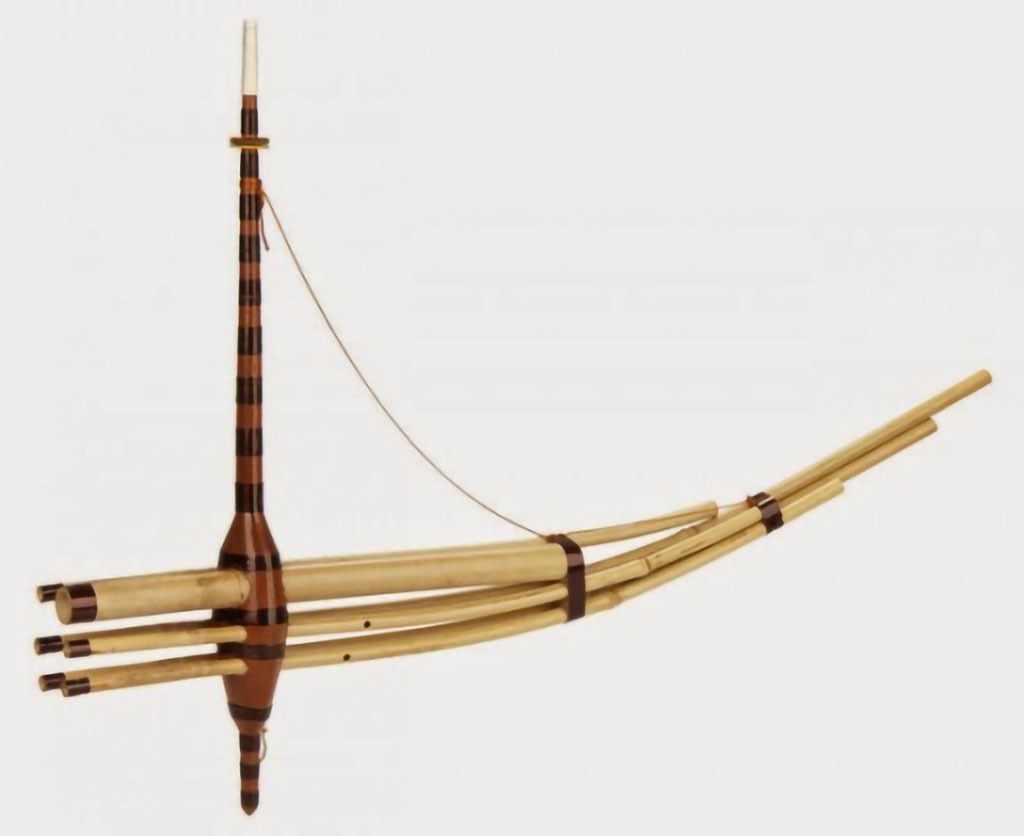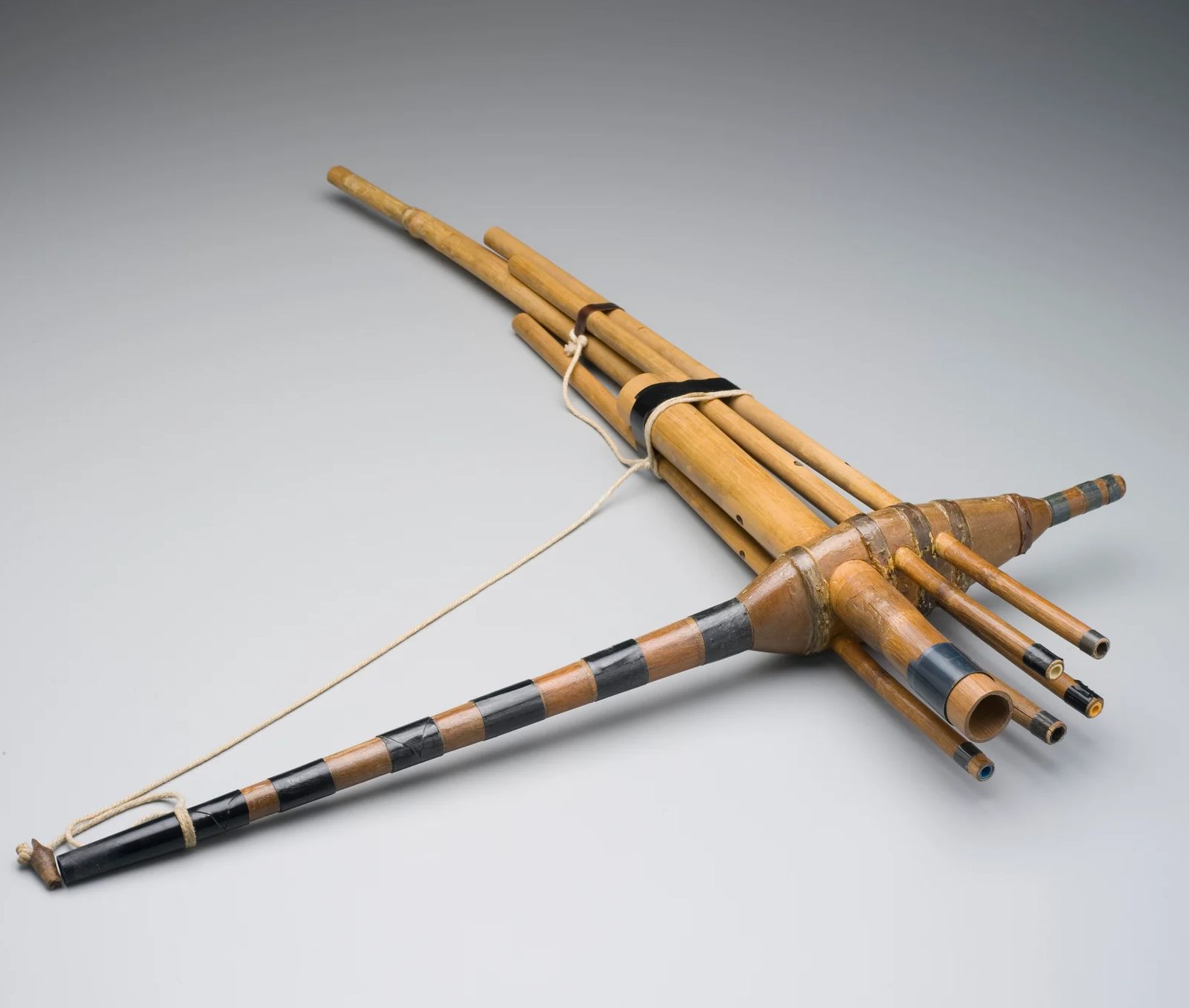Qeej
Woodwinds
Asia
Ancient
Video
The Qeej (pronounced “keng”) is a traditional Hmong free-reed mouth organ with deep cultural and spiritual significance. It is one of the most distinctive and revered instruments in Hmong culture, not only for its unique sound but also for its role in storytelling, ceremonial rites, and social expression. The Qeej has been played for centuries, passed down through generations as a means of preserving oral traditions, rituals, and music. Its haunting, resonant melodies mimic the tonal qualities of the Hmong language, allowing it to communicate messages through music.
Historical Origins and Cultural Significance
The origins of the Qeej trace back thousands of years to ancient China, where similar free-reed instruments were used in folk music and religious ceremonies. The Hmong people, an ethnic group with roots in China, Vietnam, Laos, and Thailand, carried the instrument with them as they migrated throughout Southeast Asia. Over time, the Qeej evolved into a deeply symbolic instrument, integral to Hmong identity and spirituality.
In traditional Hmong culture, the Qeej is more than just a musical instrument—it is a sacred voice that bridges the worlds of the living and the dead. It is most prominently featured in Hmong funeral ceremonies, where it guides the soul of the deceased to the afterlife. The melodies played on the Qeej correspond to specific phrases in the Hmong language, relaying messages to ancestors and spirits. Apart from funerals, the Qeej is also played at weddings, New Year celebrations, and social gatherings, demonstrating its versatility in both solemn and joyous occasions.
Construction and Materials
The Qeej is a complex, handcrafted instrument made from bamboo pipes and a wooden or metal wind chamber. Its design is similar to that of other Asian free-reed mouth organs, such as the Chinese Sheng or the Laotian Khaen. A traditional Qeej consists of six bamboo pipes, each varying in length, inserted into a wooden wind chamber that contains free reeds made of metal.
Each bamboo pipe has a small metal reed inside, which vibrates when air is blown through the instrument. The pipes also have strategically placed holes that players cover or uncover to change pitches. The crafting of a Qeej is a meticulous process, requiring skilled artisans who understand not only the mechanics of sound production but also the cultural significance of the instrument.
Types of Qeej
There are several variations of the Qeej, differing in size, tuning, and purpose. Some are designed for ceremonial use, while others are built for entertainment or competition. The most common types include:
Traditional Qeej: Used primarily in Hmong funerals and rituals.
Miniature Qeej: Smaller versions used for teaching or performance.
Decorative Qeej: Non-functional models crafted for display and cultural exhibitions.
Playing Techniques and Sound Production
Playing the Qeej is a physically demanding and skill-intensive art. Unlike many wind instruments where sound is produced through blowing alone, the Qeej requires a combination of breathing techniques, fingering, and body movements to create its distinctive melodies. The musician must coordinate continuous airflow while simultaneously manipulating finger holes to produce different notes.
A unique aspect of Qeej playing is the integration of dance movements. Skilled players often move rhythmically, swaying or even kneeling while playing, which enhances the expressive nature of the music. This dynamic performance style is particularly evident during Hmong New Year celebrations, where Qeej players engage in Qeej dance competitions to showcase their agility and mastery of the instrument.
The sound of the Qeej is deep, resonant, and expressive, capable of imitating human speech patterns. This allows it to convey messages in Hmong poetic verse, making it an essential tool for oral storytelling and communication with the spiritual realm.
Role of Qeej in music
Role in Hmong Funeral Ceremonies
One of the most significant roles of the Qeej is in Hmong funeral rituals. The instrument serves as a guide for the deceased, ensuring that their soul finds its way to the afterlife. The melodies played on the Qeej correspond to specific spoken words and phrases in the Hmong language, essentially narrating the journey of the soul.
Funeral Qeej music is highly ritualistic, requiring players to learn specific sequences that must be performed in the correct order. These songs tell stories of the deceased’s life, recounting their journey and calling upon ancestors to welcome them. The playing of the Qeej during funerals is considered an act of respect and duty, with experienced musicians often dedicating years to mastering these sacred melodies.
Modern Adaptations and Innovations
In contemporary times, the Qeej has adapted to new musical settings while still preserving its traditional roots. Some Hmong musicians have experimented with fusion music, incorporating the Qeej into modern genres such as jazz, hip-hop, and electronic music. This blending of old and new allows younger generations to connect with their heritage while also appealing to a broader audience.
Hmong communities in the United States, France, and other parts of the world have continued to revive and promote the Qeej through cultural festivals, workshops, and competitions. Technological advancements have also made it possible for musicians to record and share Qeej music globally, helping to preserve this unique art form for future generations.
Challenges and Efforts in Preservation
Despite its deep cultural significance, the Qeej faces challenges in preservation and continuity. The complex nature of Qeej playing requires years of dedicated practice, and fewer young Hmong are taking up the instrument due to modern influences and migration. Additionally, the oral transmission of Qeej knowledge means that if skilled players do not pass down their expertise, valuable musical traditions could be lost.
To address this, various cultural organizations and Hmong elders are actively teaching Qeej-playing techniques, organizing competitions, and even developing written notations and online tutorials to make learning more accessible. These efforts aim to ensure that the Qeej remains a living tradition, continuously evolving while retaining its cultural essence.
The Qeej is more than just a musical instrument—it is a cultural emblem, a spiritual guide, and a storyteller of the Hmong people. Its hauntingly beautiful melodies, intricate craftsmanship, and profound role in ceremonies make it one of the most revered instruments in Southeast Asian traditions. As efforts continue to preserve and adapt Qeej music to modern settings, it remains a powerful symbol of Hmong resilience and cultural identity. Through education, innovation, and community engagement, the legacy of the Qeej will endure for generations to come.
FAQ
Who made the Qeej musical instrument?
The Qeej is traditionally made by Hmong artisans who specialize in crafting this sacred instrument. It is handcrafted from bamboo pipes and a wooden wind chamber. Skilled makers carve intricate details to ensure proper sound production. The Qeej is both a musical and spiritual tool in Hmong culture.
What materials is the Qeej made of?
The Qeej is primarily made of bamboo, which forms its six pipes of varying lengths. The wind chamber is crafted from wood, often with metal reeds inside to create its signature drone. Beeswax is sometimes used to seal air leaks. The choice of materials ensures its distinct, resonant sound.
What kind of music is played with the Qeej?
The Qeej is used mainly in Hmong traditional ceremonies, particularly funerals and celebrations. Its melodies mimic Hmong spoken language, conveying messages and storytelling. It is often accompanied by ritual dances. The instrument plays a crucial role in guiding spirits in Hmong beliefs.
 Links
Links
References
- Learn About Hmong: Qeej
- Grinnell College Musical Instrument Collection: qeej
- Hmong Studies Journal: The Hmong Qeej Speaking to the Spirit World
- Washington University: Traditional Instruments at New Year Celebrations
- Minnesota Digital Library: Qeej Musical Instrument Curriculum
- YouTube Video: The Extraordinary Hmong Mouth Organ "Qeej"
Other Instrument
Categories



















